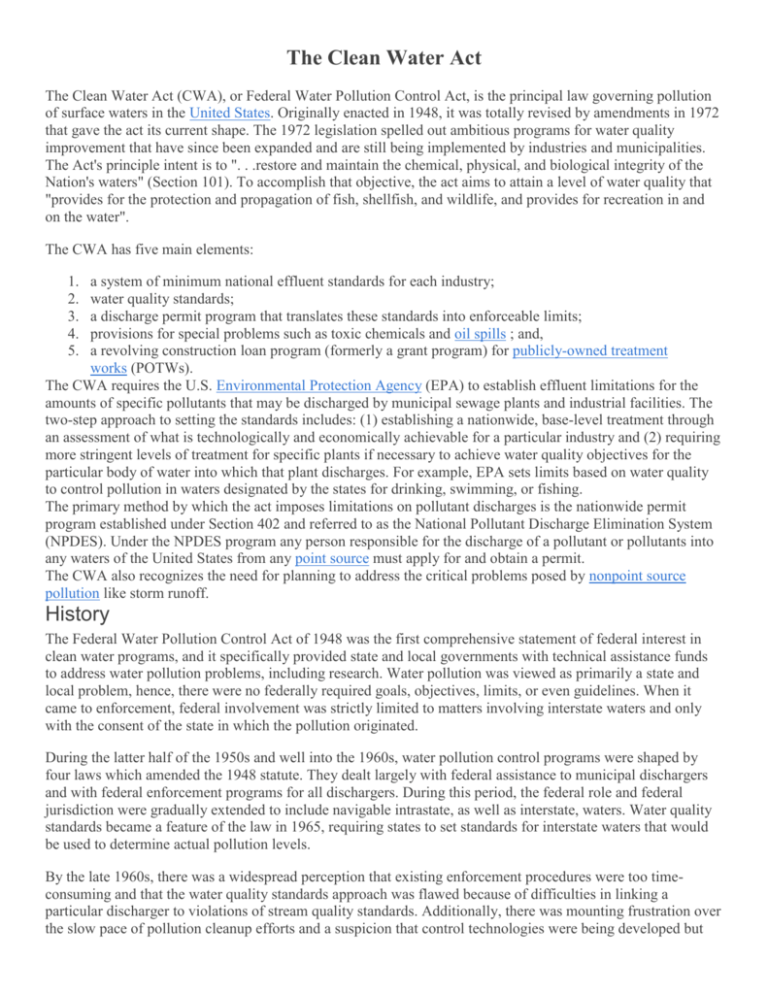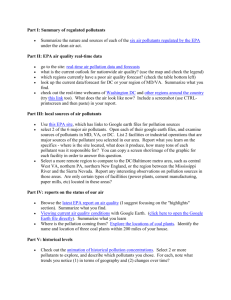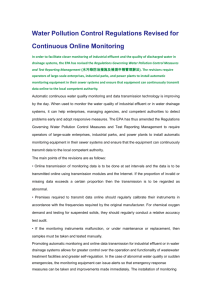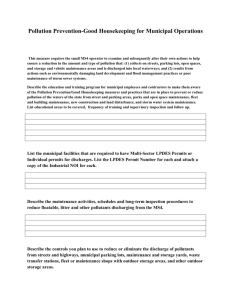The Clean Water Act - Mrs. Chick AP Environmental Systems
advertisement

The Clean Water Act The Clean Water Act (CWA), or Federal Water Pollution Control Act, is the principal law governing pollution of surface waters in the United States. Originally enacted in 1948, it was totally revised by amendments in 1972 that gave the act its current shape. The 1972 legislation spelled out ambitious programs for water quality improvement that have since been expanded and are still being implemented by industries and municipalities. The Act's principle intent is to ". . .restore and maintain the chemical, physical, and biological integrity of the Nation's waters" (Section 101). To accomplish that objective, the act aims to attain a level of water quality that "provides for the protection and propagation of fish, shellfish, and wildlife, and provides for recreation in and on the water". The CWA has five main elements: 1. 2. 3. 4. 5. a system of minimum national effluent standards for each industry; water quality standards; a discharge permit program that translates these standards into enforceable limits; provisions for special problems such as toxic chemicals and oil spills ; and, a revolving construction loan program (formerly a grant program) for publicly-owned treatment works (POTWs). The CWA requires the U.S. Environmental Protection Agency (EPA) to establish effluent limitations for the amounts of specific pollutants that may be discharged by municipal sewage plants and industrial facilities. The two-step approach to setting the standards includes: (1) establishing a nationwide, base-level treatment through an assessment of what is technologically and economically achievable for a particular industry and (2) requiring more stringent levels of treatment for specific plants if necessary to achieve water quality objectives for the particular body of water into which that plant discharges. For example, EPA sets limits based on water quality to control pollution in waters designated by the states for drinking, swimming, or fishing. The primary method by which the act imposes limitations on pollutant discharges is the nationwide permit program established under Section 402 and referred to as the National Pollutant Discharge Elimination System (NPDES). Under the NPDES program any person responsible for the discharge of a pollutant or pollutants into any waters of the United States from any point source must apply for and obtain a permit. The CWA also recognizes the need for planning to address the critical problems posed by nonpoint source pollution like storm runoff. History The Federal Water Pollution Control Act of 1948 was the first comprehensive statement of federal interest in clean water programs, and it specifically provided state and local governments with technical assistance funds to address water pollution problems, including research. Water pollution was viewed as primarily a state and local problem, hence, there were no federally required goals, objectives, limits, or even guidelines. When it came to enforcement, federal involvement was strictly limited to matters involving interstate waters and only with the consent of the state in which the pollution originated. During the latter half of the 1950s and well into the 1960s, water pollution control programs were shaped by four laws which amended the 1948 statute. They dealt largely with federal assistance to municipal dischargers and with federal enforcement programs for all dischargers. During this period, the federal role and federal jurisdiction were gradually extended to include navigable intrastate, as well as interstate, waters. Water quality standards became a feature of the law in 1965, requiring states to set standards for interstate waters that would be used to determine actual pollution levels. By the late 1960s, there was a widespread perception that existing enforcement procedures were too timeconsuming and that the water quality standards approach was flawed because of difficulties in linking a particular discharger to violations of stream quality standards. Additionally, there was mounting frustration over the slow pace of pollution cleanup efforts and a suspicion that control technologies were being developed but not applied to the problems. These perceptions and frustrations, along with increased public interest in environmental protection, set the stage for the 1972 amendments. The 1972 statute did not continue the basic components of previous laws as much as it set up new ones. It set optimistic and ambitious goals, required all municipal and industrial wastewater to be treated before being discharged into waterways, increased federal assistance for municipal treatment plant construction, strengthened and streamlined enforcement, and expanded the federal role while retaining the responsibility of states for dayto-day implementation of the law. The 1972 legislation declared as its objective the restoration and maintenance of the chemical, physical, and biological integrity of the nation’s waters. Two goals also were established: zero discharge of pollutants by 1985 and, as an interim goal and where possible, water quality that is both “fishable” and “swimmable” by mid1983. While those dates have passed, the goals remain, and efforts to attain the goals continue. Over the years, many other laws have changed parts of the Clean Water Act. Title I of the Great Lakes Critical Programs Act of 1990, for example, put into place parts of the Great Lakes Water Quality Agreement of 1978, signed by the U.S. and Canada, where the two nations agreed to reduce certain toxic pollutants in the Great Lakes. That law required EPA to establish water quality criteria for the Great Lakes addressing 29 toxic pollutants with maximum levels that are safe for humans, wildlife, and aquatic life. It also required EPA to help the States implement the criteria on a specific schedule. The Oil Pollution Act of 1990 tightened regulations concerning the discharge of oil and hazardous substances. The Great Lakes Critical Program Act of 1990 focused on protecting the integrity of the Great Lakes; both Canada and the U.S. agreed to reduce discharge of certain toxic pollutants contaminating the Great Lakes at the time. For many years following the passage of CWA in 1972, EPA , states, and Indian tribes focused mainly on the chemical aspects water pollution . Recently, more attention has been given to physical and biological integrity. Also, in the early decades of the Act's implementation, efforts focused on regulating discharges from traditional " point source " facilities, such as municipal sewage plants and industrial facilities, with little attention paid to runoff from streets, construction sites, farms, and other "wet-weather" sources. Starting in the late 1980s, efforts to address polluted runoff have increased significantly. For " nonpoint " runoff, voluntary programs, including cost-sharing with landowners are the key tool. For "wet weather point sources" like urban storm sewer systems and construction sites, a regulatory approach is being employed. Evolution of CWA programs over the last decade has also included something of a shift from a program-byprogram, source-by-source, pollutant-by-pollutant approach to more holistic watershed -based strategies. Under the watershed approach equal emphasis is placed on protecting healthy waters and restoring impaired ones. A full array of issues are addressed, not just those subject to CWA regulatory authority. Involvement of stakeholder groups in the development and implementation of strategies for achieving and maintaining state water quality and other environmental goals is another hallmark of this approach. Table 1. Clean Water Act and Major Amendments (codified generally at 33 U.S.C. 1251-1387) Year Act 1948 Federal Water Pollution Control Act Public Law Number P.L. 80-845 (Act of June 30, 1948) 1956 Water Pollution Control Act of 1956 P.L. 84-660 (Act of July 9, 1956) 1961 Federal Water Pollution Control Act Amendments P.L. 87-88 1965 Water Quality Act of 1965 P.L. 89-234 1966 Clean Water Restoration Act P.L. 89-753 1970 Water Quality Improvement Act of 1970 P.L. 91-224, Part I 1972 Federal Water Pollution Control Act Amendments P.L. 92-500 1977 Clean Water Act of 1977 P.L. 95-217 1981 Municipal Wastewater Treatment Construction Grants Amendments P.L. 97-117 1987 Water Quality Act of 1987 P.L. 100-4 General The Clean Water Act (CWA) today consists of two major parts, one being the Title II and Title VI provisions which authorize federal financial assistance for municipal sewage treatment plant construction. The other is regulatory requirements, found throughout the act, that apply to industrial and municipal dischargers. The act has been termed a technology-forcing statute because of the rigorous demands placed on those who are regulated by it to achieve higher and higher levels of pollution abatement. Industries were given until July 1, 1977, to install “best practicable control technology” (BPT) to clean up waste discharges. Municipal wastewater treatment plants were required to meet an equivalent goal, termed “secondary treatment,” by that date. (Municipalities unable to achieve secondary treatment by that date were allowed to apply for case-by-case extensions up to July 1, 1988. According to EPA, 86% of all cities met the 1988 deadline; the remainder were put under judicial or administrative schedules requiring compliance as soon as possible. However, many cities, especially smaller ones, continue to make investments in building or upgrading facilities needed to achieve secondary treatment.) Cities that discharge wastes into marine waters were eligible for case-by-case waivers of the secondary treatment requirement, where sufficient showing could be made that natural factors provide significant elimination of traditional forms of pollution and that both balanced populations of fish, shellfish, and wildlife and water quality standards would be protected. The act required greater pollutant cleanup than BPT by no later than March 31, 1989, generally demanding that industry use the “best available technology” (BAT) that is economically achievable. Compliance extensions of as long as two years are available for industrial sources utilizing innovative or alternative technology. Failure to meet statutory deadlines could lead to enforcement action. Control of toxic pollutant discharges has been a key focus of water quality programs. In addition to the BPT and BAT national standards, states are required to implement control strategies for waters expected to remain polluted by toxic chemicals even after industrial dischargers have installed the best available cleanup technologies required under the law. Development of management programs for these post-BAT pollutant problems was a prominent element in the 1987 amendments and is a key continuing aspect of CWA implementation. Prior to the 1987 amendments, programs in the Clean Water Act were primarily directed at pointsource pollution—wastes discharged from discrete and identifiable sources, such as pipes and other outfalls. In contrast, except for general planning activities, little attention had been given to nonpoint-source pollution (stormwater runoff from agricultural lands, forests, construction sites, and urban areas), despite estimates that it represents more than 50% of the nation’s remaining water pollution problems. As it travels across land surface towards rivers and streams, rainfall and snowmelt runoff picks up pollutants, including sediments, toxic materials, and conventional wastes (e.g., nutrients) that can degrade water quality. The 1987 amendments authorized measures to address such pollution by directing states to develop and implement nonpoint pollution management programs (Section 319 of the act). States were encouraged to pursue groundwater protection activities as part of their overall nonpoint pollution control efforts. Federal financial assistance was authorized to support demonstration projects and actual control activities. These grants may cover up to 60% of program implementation costs. While the act imposes great technological demands, it also recognizes the need for comprehensive research on water quality problems. This is provided throughout the statute, on topics including pollution in the Great Lakes and Chesapeake Bay, in-place toxic pollutants in harbors and navigable waterways, and water pollution resulting from mine drainage. The act also provides support to train personnel who operate and maintain wastewater treatment facilities. Under the Clean Water Act, it is unlawful for any person to discharge any substance classified as a pollutant from a point source into navigable waters. Some significant amendments succeeding the Clean Water Act include revisions in 1977, 1987, and 1990. The Clean Water Act of 1977 restructured the 1972 Act while adding new control programs for toxic water pollutants. Revisions in 1981 streamlined the municipal construction grants process, improving the capabilities of treatment plants built under the program. Changes in 1987 phased out the construction grants program, replacing it with the State Water Pollution Control Revolving Fund, more commonly known as the Clean Water State Revolving Fund. This new funding strategy addressed water quality needs by building on EPA-State partnerships. Federal and State Responsibilities Under this act, federal jurisdiction is broad, particularly regarding establishment of national standards or effluent limitations. The Environmental Protection Agency (EPA) issues regulations containing the BPT and BAT effluent standards applicable to categories of industrial sources (such as iron and steel manufacturing, organic chemical manufacturing, petroleum refining, and others). Certain responsibilities are delegated to the states, and this act, like other environmental laws, embodies a philosophy of federal-state partnership in which the federal government sets the agenda and standards for pollution abatement, while states carry out day-to-day activities of implementation and enforcement. Delegated responsibilities under the act include authority for qualified states to issue discharge permits to industries and municipalities and to enforce permits. (As of January 2010, 46 states had been delegated the permit program; EPA issues discharge permits in the remaining states and the District of Columbia.) In addition, states are responsible for establishing water quality standards, which consist of a designated use (recreation, water supply, industrial, or other), plus a numerical or narrative statement identifying maximum concentrations of various pollutants which would not interfere with the designated use. These standards serve as the backup to federally set technology-based requirements by indicating where additional pollutant controls are needed to achieve the overall goals of the act. Titles II and VI—Municipal Wastewater Treatment Construction Federal law has authorized grants for planning, design, and construction of municipal sewage treatment facilities since 1956 (Act of July 9, 1956, or P.L. 84-660). Congress greatly expanded this grant is program in 1972. Since that time Congress has authorized $65 billion and appropriated more than $85 billion in Clean Water Act funds to aid wastewater infrastructure plant construction (not including congressionally earmarked appropriations for specific projects). Grants are allocated among the states according to a complex statutory formula that combines two factors: state population and an estimate of municipal sewage treatment funding needs derived from a biennial survey conducted by EPA and the states. The most recent EPA-state estimate, completed in 2008, indicated that nearly $203 billion is needed to build and upgrade needed municipal wastewater treatment plants in the United States and for other types of water quality improvement projects that are eligible for funding under the act. In 2002, EPA released a new report called the Gap Analysis which estimated that, over the next two decades, the United States needs to spend nearly $390 billion to replace existing wastewater infrastructure systems and to build new ones. Estimates of future funding needs and questions about federal support continue to be prominent. Under the Title II construction grants program established in 1972, federal grants were made for several types of projects (such as secondary or more stringent treatment and associated sewers) based on a priority list established by the states. Grants were generally available for as much as 55% of total project costs. For projects using innovative or alternative technology (such as reuse or recycling of water), as much as 75% federal funding was allowed. Recipients were responsible for non-federal costs but were not required to repay federal grants. Policymakers have debated the tension between assisting municipal funding needs, which remain large, and the impact of grant programs such as the Clean Water Act’s on federal spending and budget deficits. In the 1987 amendments to the act, Congress attempted to deal with that apparent conflict by extending federal aid for wastewater treatment construction through FY1994, yet providing a transition towards full state and local government responsibility for financing after that date. Grants under the traditional Title II program were authorized through FY1990. Under Title VI of the act, grants to capitalize State Water Pollution Control Revolving Funds, or loan programs, were authorized beginning in FY1989 to replace the Title II grants. States contribute matching funds, and under the revolving loan fund concept, monies used for wastewater treatment construction will be repaid to a state, to be available for future construction in other communities. All states now have functioning loan programs, but the shift from federal grants to loans, since FY1991, has been easier for some than others. The new financing requirements have been a problem for cities (especially small towns) that have difficulty repaying project loans. Statutory authorization for grants to capitalize state loan programs expired in 1994; however, Congress has continued to provide annual appropriations. Permits, Regulations, and Enforcement To achieve its objectives, the act embodies the concept that all discharges into the nation’s waters are unlawful, unless specifically authorized by a permit. Thus, more than 65,000 industrial and municipal dischargers must obtain permits from EPA (or qualified states) under the act’s National Pollutant Discharge Elimination System (NPDES) program (authorized in Section 402 of the act). An NPDES permit requires the discharger (source) to attain technology-based effluent limits (BPT or BAT for industry, secondary treatment for municipalities, or more stringent for water quality protection). Permits specify the control technology applicable to each pollutant, the effluent limitations a discharger must meet, and the deadline for compliance. Sources are required to maintain records and to carry out effluent monitoring activities. Permits are issued for five-year periods and must be renewed thereafter to allow continued discharge. The NPDES permit incorporates numerical effluent limitations issued by EPA. The initial BPT limitations focused on regulating discharges of conventional pollutants, such as bacteria and oxygen-consuming materials. The more stringent BAT limitations emphasize controlling toxic pollutants—heavy metals, pesticides, and other organic chemicals. In addition to these limitations applicable to categories of industry, EPA has issued water quality criteria for more than 115 pollutants, including 65 named classes or categories of toxic chemicals, or “priority pollutants.” These criteria recommend ambient, or overall, concentration levels for the pollutants and provide guidance to states for establishing water quality standards that will achieve the goals of the act. A separate type of permit is required to dispose of dredge or fill material in the nation’s waters, including wetlands. Authorized by Section 404 of the act, this permit program is administered by the U.S. Army Corps of Engineers, subject to and using EPA’s environmental guidance. Some types of activities are exempt from these permit requirements, including certain farming, ranching, and forestry practices which do not alter the use or character of the land; some construction and maintenance; and activities already regulated by states under other provisions of the act. EPA may delegate certain Section 404 permitting responsibility to qualified states and has done so twice (Michigan and New Jersey). For some time, the act’s wetlands permit program has been one of the most controversial parts of the law. Some who wish to develop wetlands maintain that federal regulation intrudes on and impedes private land-use decisions, while environmentalists seek more protection for remaining wetlands and limits on activities that take place in wetlands. Nonpoint sources of pollution, which EPA and states believe are responsible for the majority of water quality impairments in the nation, are not subject to CWA permits or other regulatory requirements under federal law. They are covered by state programs for the management of runoff, under Section 319 of the act. Other EPA regulations under the CWA include guidelines on using and disposing of sewage sludge and guidelines for discharging pollutants from land-based sources into the ocean. (A related statute, the Ocean Dumping Act, regulates the intentional disposal of wastes into ocean waters.) EPA also provides guidance on technologies that will achieve BPT, BAT, and other effluent limitations. The NPDES permit, containing effluent limitations on what may be discharged by a source, is the act’s principal enforcement tool. EPA may issue a compliance order or bring a civil suit in U.S. district court against persons who violate the terms of a permit. The penalty for such a violation can be as much as $25,000 per day. Stiffer penalties are authorized for criminal violations of the act—for negligent or knowing violations—of as much as $50,000 per day, three years’ imprisonment, or both. A fine of as much as $250,000, 15 years in prison, or both, is authorized for “knowing endangerment”—violations that knowingly place another person in imminent danger of death or serious bodily injury. Finally, EPA is authorized to assess civil penalties administratively for certain well-documented violations of the law. These civil and criminal enforcement provisions are contained in Section 309 of the act. EPA, working with the Army Corps of Engineers, also has responsibility for enforcing against entities who engage in activities that destroy or alter wetlands. While the CWA addresses federal enforcement, the majority of actions taken to enforce the law are undertaken by states, both because states issue the majority of permits to dischargers and because the federal government lacks the resources for day-to-day monitoring and enforcement. Like most other federal environmental laws, CWA enforcement is shared by EPA and states, with states having primary responsibility. However, EPA has oversight of state enforcement and retains the right to bring a direct action where it believes that a state has failed to take timely and appropriate action or where a state or local agency requests EPA involvement. Finally, the federal government acts to enforce against criminal violations of the federal law. In addition, individuals may bring a citizen suit in U.S. district court against persons who violate a prescribed effluent standard or limitation. Individuals also may bring citizen suits against the Administrator of EPA or equivalent state official (where program responsibility has been delegated to the state) for failure to carry out a nondiscretionary duty under the act. Note: Significant potions of this article were extracted from from the Congressional Research Service Report RL30798, Environmental Laws: Summaries of Major Statutes Administered by the Environmental Protection Agency by David M. Bearden, Claudia Copeland, Linda Luther, James E. McCarthy, Linda-Jo Schierow, and Mary Tiemann (October 8, 2010). Further Reading ChemAlliance.org. Clean Water Act Background . U.S. Environmental Protection Agency. Summary of the Clean Water Act . CRS Report: Clean Water Act: A Summary of the Law Citation (2012). Clean Water Act, United States. Retrieved from http://www.eoearth.org/view/article/151133









